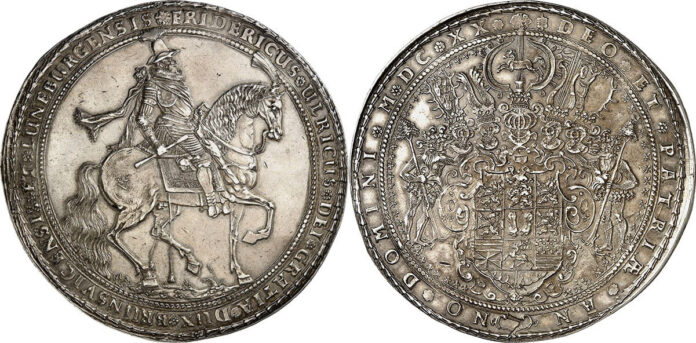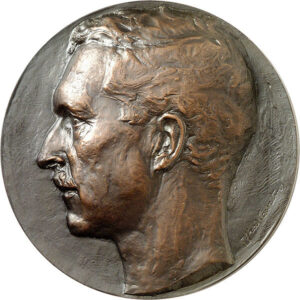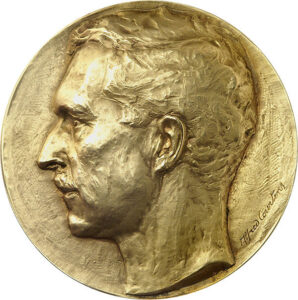Künker’s 350th Auction: A Firework of Numismatics!
Künker’s 350th auction will take place from 29 June to 1 July 2021. This is another highlight of Künker’s anniversary year because on 1 July 1971 – exactly 50 years ago – Münzenhandlung Fritz Rudolf Künker was founded. Even though it isn’t known yet whether the Covid situation in Osnabrück will allow for bidders to participate in the sale in person, the material on offer is sure to attract worldwide attention. Many a great rarity from Germany and abroad will change hands during the three auction days. The finest specimens of several extensive private collections can be found in the catalog, for example coins and medals from Bavaria, Brandenburg-Prussia, Bremen, Hesse, Lübeck, the Palatinate and Würzburg. Another part of the Popken Collection with selected lösers from Brandenburg will certainly be the highlight of the auction sale.
Selected Lösers from the Popken Collection
On the occasion of the anniversary auction, 51 impressive lösers will be offered. They stem from the Friedrich Popken Collection and represent the second part of this field of his collection. Many of the pieces are extremely rare, some are even the only specimens available on the market. An example is a löser of 7 reichstalers from 1620 minted by Frederick Ulrich of Brunswick-Wolfenbüttel. It depicts the duke in armor with a high hat sitting on a magnificently decorated horse.
The top piece of this section is extremely rare: a löser of impressive 291.05 g worth 10 reichstalers. It features Augustus the Younger with the baton sitting on a horse, riding through a detailed mining landscape. With an estimate of 150,000 euros, this coin is the löser with the highest estimate of this section.
Another extremely rare löser of 4 reichstalers was minted in 1670. According to the detailed inscription on the reverse, it was issued by Ferdinand I Albert to commemorate the death of his son and crown prince Leopold Carl. The little prince did not even live to see his first birthday. Coins like these testify to the fact that a high infant mortality rate was normal even for high nobility in early modern times. The piece has an estimate of 125,000 euros.
Let’s conclude the preview of this part of the auction with a löser of 8 reichstalers by Christian Louis of Brunswick-Lüneburg-Celle minted in 1654. The magnificent piece features the crowned monogram of the prince on the obverse, and the horse of Brunswick crowned with a laurel featured above a city view of Celle on the reverse. This wonderful piece with an estimate of 100,000 euros has already attracted the attention of many collectors including Virgil Brand and Dr Koch.
German Coins – Gold and Silver
It is quite difficult to decide which coins to present in this preview when it comes to the 1,727 German coins and medals that will be auctioned off in Künker’s anniversary auction 350. The top pieces of several collections are on offer: there are large series from Bavaria, Brandenburg-Prussia, Bremen, Lübeck, the Palatinate, Saxony and Würzburg, to name but a few. We present some very special pieces:
Everything started with a dream wedding that was the occasion to mint the spectacular medal of the Bavarian estates offered at Künker: Max Emanuel, the Blue Elector, acclaimed hero of the liberation of Vienna, married the emperor’s daughter. No one could have guessed back then that their son wouldn’t inherit the Spanish throne as planned but was to die very young. This disappointment led Max Emanuel to the French side, which resulted in Bavaria being conquered by the Habsburgs.
Another highlight among the issues from Germany is an extremely rare gold gulden from Bremen issued on behalf of George, Duke of Brunswick. The bishop, who was elected to his office in 1558, is of crucial importance for Bremen’s church history: he allowed the Reformation to be adopted.
Only three gold versions of a Hessian medal were minted on the occasion of the erection of Ludwig’s Column in Darmstadt. Louis II of Hesse, the commissioner of Ludwig’s Column and the medal, was so unpopular that he had this monument erected in an attempt to profit by the popularity of his father, who died in 1830.
Not one but two Nuremberg issues – a 6fold and a 5fold ducat – commemorate the Peace of Rijswijk in 1698. Recently, in Künker Auction 346, such a commemorative issue of 5 ducats sold for 120,000 euros. We’ll see what these two coins will achieve.
There are many interesting pieces among the silver and bronze issues, too. One of them is a broad 2 1/2fold taler of the city of Cologne minted in 1581. It is the only known specimen in private possession, and its provenance can be traced back to 1893. The commissioner of this piece, Bishop Gebhard Truchsess von Waldburg, planned to convert to Protestantism himself and secularize the archbishopric for his love to a high-ranking, Protestant canoness. This was a clear violation of the Peace of Augsburg and resulted in the Cologne War. The representative taler was created after the Pope had confirmed him being elected Catholic archbishop, and before he had converted to Protestantism and married his beloved.
An important piece for the monetary history of northern Germany is a Goslar taler of 1531. It is the result of an arbitration award of the Imperial Diet, which determined in 1530 that the silver yield of Rammelsberg should be divided between the dukes of Brunswick and the city of Goslar.
Finally, it needs to be mentioned that in addition to all the rarities from the German states there’s obviously also a wealth of issues of the German Empire, including several high-ranking showpieces of the finest quality such as “Bavarian Wedding” and “Frederick the Wise”.
World Issues – Gold and Silver
The wealth of world coins offered in auction 350 ranges from A to Z, from the 8th to the 21th century. Here, too, you can find numismatic rarities from many countries. We have to limit this preview to a few examples.
Let’s start our numismatic trip in Belgium. Here, a 10fold souverain d’or of 1751 catches our attention. On the obverse, it features the portrait of Emperor Francis I, who’s rather known as the husband of Maria Theresa today. The splendid multiple gold coin minted in Antwerp has an estimate of 100,000 euros.
Then, our journey takes us to Italy. A 6fold doppie of 1786 was minted there on behalf of Ferdinando di Borbone. This ruler is called that way to avoid mentioning the confusing variety of titles he accumulated in the many offices he held: he was called Ferdinand I, III or IV depending on whether he was referred to as King of Naples, Sicily or the united Kingdom of the Two Sicilies. In the Northern Italian town of Parma he even used a different title. He called himself duke because Parma only belonged to his empire because the Habsburgs had ceded it to the Spanish Bourbons after the War of the Austrian Succession. But that was just a brief episode before Napoleon shook up things throughout Italy.
Speaking of Napoleon, those interested in the first French emperor will find a wealth of impressive medals in Künker’s anniversary auction, for example, an extremely rare silver medal commemorating the birth of Napoleon’s son minted in Vienna. After all, the mother of the King of Rome – as the little child was referred to – was the daughter of the Austrian emperor.
Speaking of medals: let’s continue our numismatic journey and travel to the Netherlands, where connoisseurs of medal art will find a wealth of impressive pieces. These small works of art do not only show us how the Dutch wanted their history to be perceived, in rare cases they also provide insight into social history. As an example, we can mention a silver medal with an estimate of only 150 euros. It is dedicated to the widows’ fund of The Hague, i.e. a charitably institution that supported women who had lost their breadwinner.
Let’s make a big jump from the Netherlands to Russia, but let’s stick to the field of medals: The Swiss medalist Hedlinger created an extremely rare medal commemorating Empress Anna, which is now one of the great Russian rarities and estimated at 20,000 euros in Künker’s anniversary auction.
We will complete our numismatic journey with a last stop in colonial India. Künker offers a British prize medal that was created in London by William Wyon for the College of Fort William, today’s Kolkata. The piece on offer was awarded just a year before this important institution had to close in 1854. India and the Western world thus lost an important scholarly institution that had collected, researched and systematized the languages and literature of the Indian subcontinent. The College translated thousands of books from Arabic, Persian, Sanskrit, Bengali, Hindi and Urdu into English. Regarding many languages, the first systematic grammars and dictionaries were produced there.
Special Collection Coin Sets
The history of coin collecting in the 19th and 20th centuries has not been written yet; thus we don’t know when mints began to issue attractive annual sets for collectors. But whoever will start researching this field one day will have to take a look at Künker’s anniversary catalog: the abundance of coin sets offered in it is enormous.
No less than three British proof sets created before the First World War can be found here: from 1887 (estimate: 25,000 euros), 1893 (estimate: 50,000 euros) and 1911 (estimate: 25,000 euros).
While the value of today’s coin sets are solely determined by their low face value, coin sets issued in the 19th century were of high face value as well as material value. They only contained gold and silver coins, small change made of base metal was not considered worth collecting.
By the way, only a few coin sets were issued before 1970, when the Royal Mint in Llantrisant began to issue an official coin set each year with the change to decimal currency.
An official coin set of the Rome Mint of 1936 contains every Italian coin issued that year from the 5 centesimi piece to the 100 lire gold specimen. Unfortunately, we don’t know how many coin sets were produced and in which years the Italian Mint issued coin sets before World War II. But we do know that this set was made in a horrible year: it was the year when Mussolini announced the annexation of Ethiopia, which had been defeated by mustard gas, and the Rome-Berlin axis was first invoked.
Collectors of contemporary coinage will find many rare and interesting coin sets from exotic countries in Künker’s anniversary auction, which were produced in the late 1960s and early 1970s. An example is a Bhutan coin set from 1966, of which only 598 specimens exist.
Coin sets are wonderful testimonies to what a country took pride in, as a coin set from 1971 made in Iran demonstrates: Mohammed Reza Pahlevi staged himself as the heir to the Persian Empire.
In addition to coin sets, connoisseurs will also find a set containing three medals – gold, silver and bronze – created in 1928 by Alfred Courtens as prize medals of the Fonds National de la Recherche Scientifique on behalf of the Belgian King Albert I. It is quite likely that this set was made for Queen Elizabeth of Belgium.
Habsburg Hereditary Lands and Austria
Rare ducats, magnificent talers and impressive multiple gold coins – these are the highlights of the section Habsburg hereditary lands and Austria. Special collectors will be amazed by ducats from Judenburg, Klagenfurt, Breslau and Prague.
The 5fold ducat of perfect quality which was minted in 1690 for Leopold I in Graz is sure to attract the attention of the bidders, just like the 3fold ducat of 1694 which was also minted for Leopold I, but in Klausenburg, and graded by MS63 by NGC. The extremely rare triple ducat for Joseph II, the reform emperor, was created much later. Künker’s experts were only able to identify one other specimen of this rarity. The piece was minted in 1778 in Karlsburg and has an estimate of 60,000 euros.
Let’s take a look at an extremely rare medal of the Palatine Elector Frederick, who went down in history as the Winter King. His historical importance is not only due to the fact that his attempt to become King of Bohemia resulted in the Thirty Years’ War, but also to his marriage to the only daughter of the English King Jacob I. After Frederick failed to achieve his goal, his daughters were left with little prospect of a marriage that befitted their status. That’s why his youngest daughter, Sophie, was willing to accept a descendant prince of Brunswick, which is why her son inherited the British crown a few decades later.
You see, nothing tells history and stories better than coins and medals. And don’t let this preview fool you. The Künker anniversary auction also contains coins starting at an estimate of 100 euros. After all, the financial value isn’t what makes coins so exciting, it’s their historical importance.
The catalog can be ordered at Künker, Nobbenburger Straße 4a, 49076 Osnabrück; phone: +49 541 962020, fax: +49 541 9620222; or via e-mail. You can access the auction catalogues online. If you want to submit your bid from your computer at home, please remember to register for this service in good time.
For further information about Künker, visit their website.


























